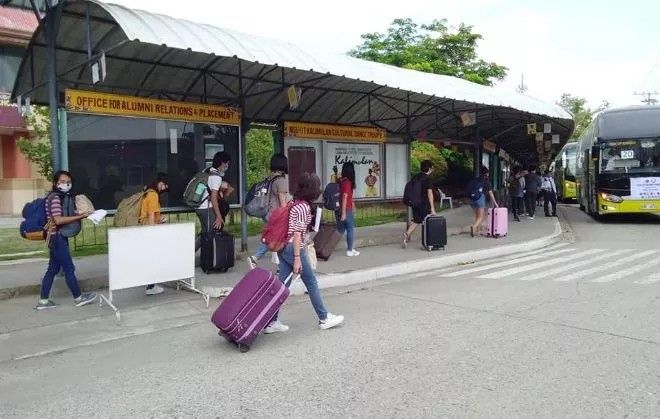MSU-IIT experts push effective testing, tracing, quarantine policies vs. pandemic

ILIGAN CITY, Philippines — Measures that will continue restricting the movement of people under 20 and over 60 years old, coupled with effective mass testing and contact tracing strategy, are critical in containing the spread of COVID-19 beyond the capacity of the healthcare system, scientists at the Mindanao State University - Iligan Institute of Technology (MSU-IIT) said.
MSU-IIT experts based this recommendation on the results of simulations they have been conducting with the help of Dr. Wolfgang Bock from Technische Universität Kaiserslautern, Germany, and under the guidance of the MOCOS (Modeling Corona Spread) international initiative. Their goal is to help policymakers craft science-based response to the pandemic.
Dr. Jinky Bornales, vice chancellor for Research and Extension at MSU-IIT, leads the MOCOS-Philippines team, with Dr. Daisy Lou Polestico and Dr. Randy Caga-anan serving as co-leaders.
They are also researchers in the Premier Research Institute of Science and Mathematics (PRISM) of MSU-IIT.
Results of the MOCOS-Philippines study assisted the local government of Iligan City in its early COVID-19 response and its later decision to extend the community quarantine.
Based on the output of their numerous simulations, members of the MOCOS-Philippines came up with the following recommendations to policymakers:
- There should be gradual lifting of the enhanced community quarantine (ECQ).
- Schools are suggested to remain closed as well as entertainment, gaming, and other public places.
- Work and essential business and transport can now resume operation, but strong social distancing should be strictly implemented with containment strategies like requiring use of masks, regular contact tracing, and good sanitary practices inside the workplaces. Scheduling of workers, work from home for selected job description, and other measures should be implemented to maintain social distancing. Restaurants and fast food centers are to remain on delivery/drive through mode.
- Social distancing and quarantine of some age-specific groups are highly recommended to slow down the progression of the infection. It is suggested that those below 20 years old and over 60 years old remain in their homes.
- While a significant decrease in the fatalities with slowed down progression of the infection can be attributed to strict implementation of social distancing measures, continued school closure, implementation of age and sector segmentation to ease suppression, with assumed good hygiene practices among the residents, it is still recommended that testing and app-augmented contact tracing should be implemented for maximum containment of the infection.
“Neither testing nor social distancing on its own is sufficient to end the epidemic. A combination of both has to be used to keep the epidemic on a level which the health system can handle. The better the testing capacity is, the higher is the detection rate for mild cases; and with an effective testing strategy, one can ease the social-distancing measures,” the MSU-IIT scientists noted.
The MOCOS group is an interdisciplinary team of scientists founded in Wroclaw, Poland by Dr. Tyll Krueger of the Wroclaw University of Science and Technology, Poland. The group at the moment is composed of three regional teams.
MOCOS-Poland is being consulted by the Polish government, while the MOCOS-Germany team is providing its simulation results to different local decision-makers in Germany.
Their main modeling idea is that not only contacts outside the household can influence the spread of the virus, but also important is its transmission inside the household. The key idea of the agent-based SIR MOCOS model is that different contact structures, and in particular the household structure, are needed to describe the spread of COVID-19.
“People may reduce their outer household contacts via social distancing, but they cannot effectively reduce contacts inside the household. This is especially true in the Philippines, where the usual household—in comparison with European countries or China—is relatively big and close-knit and may have many extended family members,” MOCOS-Philippines said. “Social distancing then cannot just simply be imposed inside the household, thus making the entire members of the family susceptible to infection.”
One of its simulations—using Iligan City as model—assumed a scenario wherein Iligan City is virus-free during the ECQ, immunity is set at 0% (which means that anyone in the city is susceptible to the infection) and 5% of those with mild symptoms are detected two days after the onset of symptoms.
Had the ECQ been totally lifted last May 1, 10 imported cases in the city would infect more than 95% of the whole population of Iligan City, or around 345,000 residents in 40 days with no social distancing measures, in 60 days with 50% reduction in social contacts, and in 90 days with 75% reduction in social contacts.
This is in stark contrast with a scenario wherein schools are still closed, individuals reduced their contacts with other persons by 50%, and the age group under-20 is added to the above-65 age group for age-specific home-quarantine measures. The results showed a decrease from 345,000 to 250,000 infected individuals in about 85 days is observed.
This is actually further lowered down when these age groups are quarantined with social distancing practices strictly observed in the workplace and essential business centers.
In 250 days after weakening lockdown, with school closure and strong social distancing measures reducing social contacts by 75% in workplaces and essential businesses and transportation, a decrease of 34.4%, or 125,000 of the residents will be infected, with 800 estimated deaths.
The MOCOS Group is continuing its effort to provide public institutions and decision-makers with case studies of different scenarios. The group is currently running microsimulations for the National Capital Region.
- Latest
- Trending



























